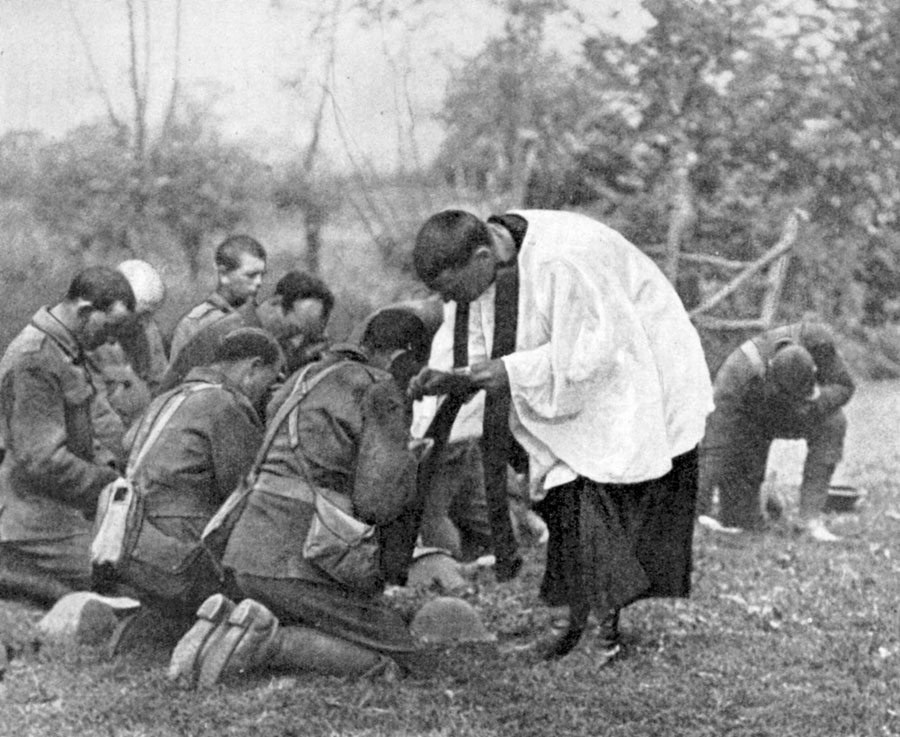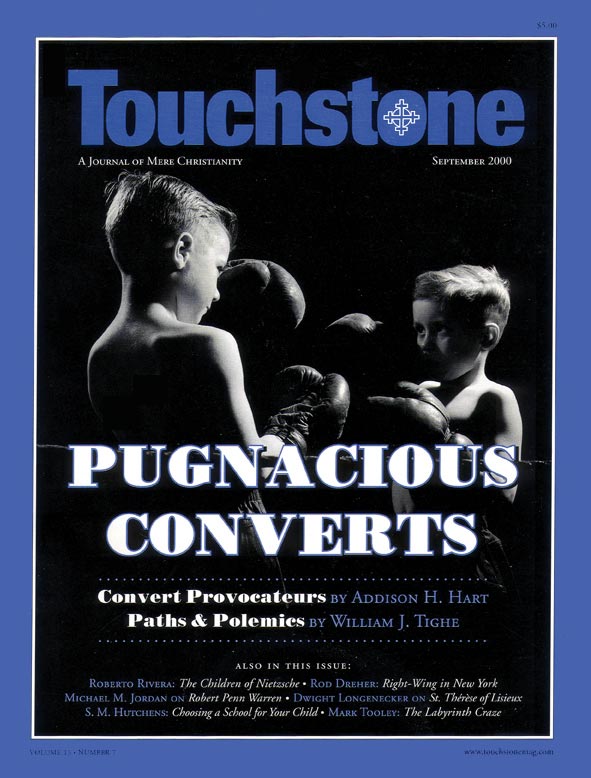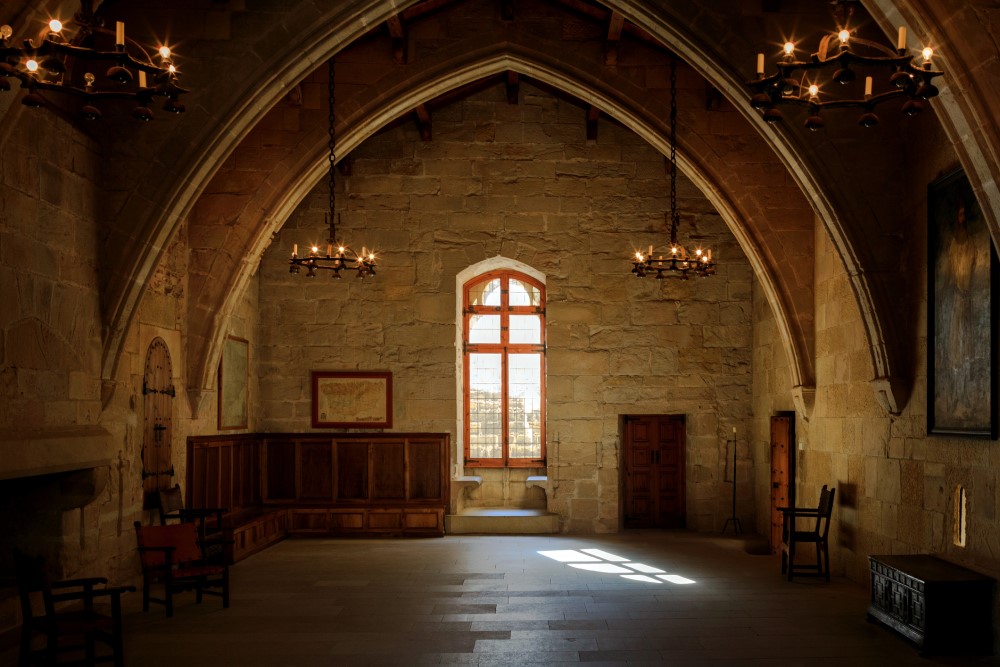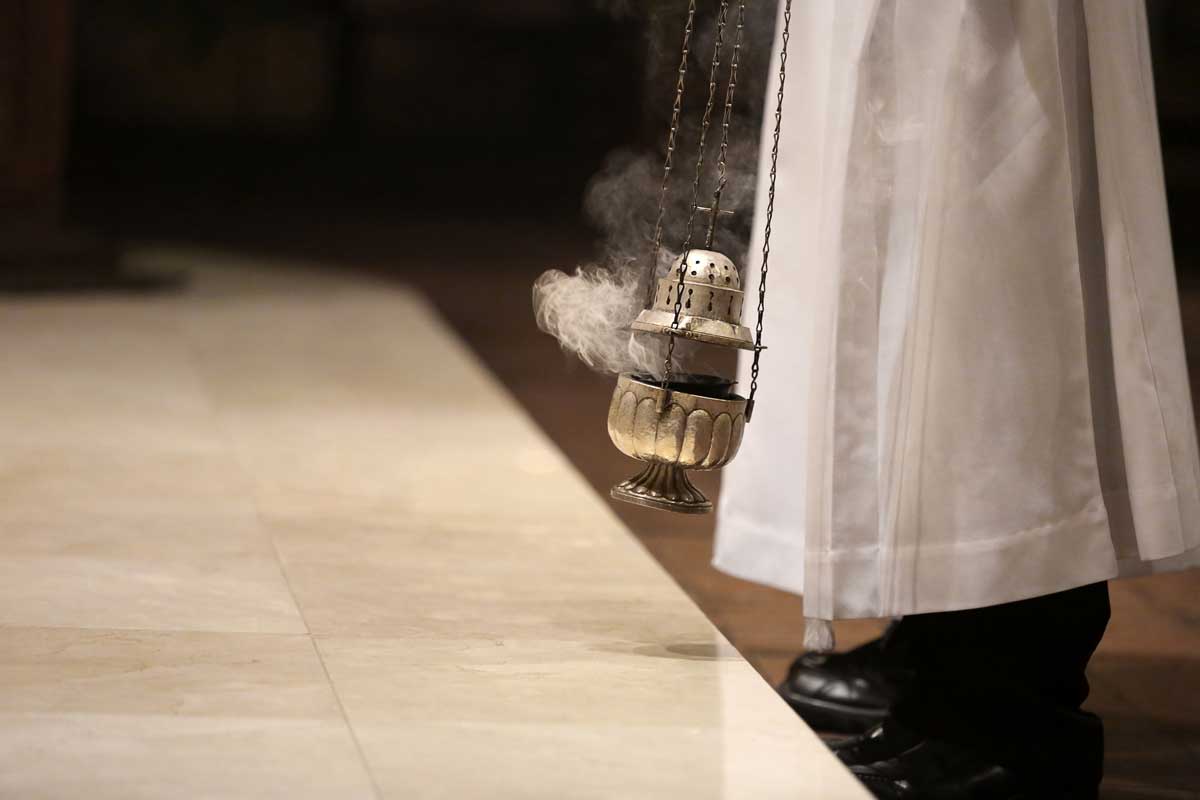Convert Provocateurs
A Plea Against Polemics Between Catholics & Orthodox
by Addison H. Hart
Both the Roman Catholic and Orthodox Churches have, during the past decade or so, received a growing number of converts from Protestantism, most notably Evangelicals searching for a “more authentic” form of Christianity. Not surprisingly, these converts tend to embrace their new Tradition with an enthusiasm and loyalty that is not generally the norm among those who were born and raised within that same Tradition.
The convert from Evangelicalism has usually thought long and hard before deciding in favor of Rome or Orthodoxy. He has probably read a good deal, discussed doctrinal concerns with priests and pastors and fellow travelers, weighed theological differences, and experimented with the various devotional and liturgical aspects of the prospective Church. Serious Evangelicals are inclined to investigate such matters rather thoroughly, and they don’t move precipitously. Converts from Evangelicalism also know what it is to be misunderstood by their Evangelical friends, to have relationships severed, even their salvation questioned and character distrusted by former friends if they opt for Catholicism or Orthodoxy. And, lastly, such a convert in search of the “more authentic” must choose between these two great claimants for the honor of being regarded as the original Church.
This last aspect of the quest is more difficult for some than for others; but here, too, there is a very definite choice to be made. If one heads Romeward, one will need to adopt a particular vision of the church’s shape and life; if one heads towards Orthodoxy, one will necessarily adopt a rather different vision of these same things. Both visions represent what is, in fact, the only surviving institution of the classical Western world; and by adopting one or the other expression of it, the convert has involved himself, like it or not, in an ecclesiological schism more historically deep-rooted than that of the Reformation (the latter presumably being more familiar to him, and providing him with his only experience of a division within Christianity).
Convert Wars
It is commendable for the convert to have actually made the trek from Evangelicalism to either Orthodoxy or Catholicism, revealing a certain farsightedness and determination. Such things are often hard won. In light of that, one can perhaps understand and forgive the defensiveness a convert might develop regarding the Church he has joined. He may no longer be vulnerable to Evangelical arguments against his faith or its practices, and he may have learned how to engage in necessary apologetics when his Church comes under such fire (former Evangelicals often become adept at this sort of thing quickly and easily).
He may also find, on occasion, that he must defend his choice of Catholicism instead of Orthodoxy, or of Orthodoxy instead of Catholicism. And here, far too often, farsightedness begins to disappear, and a sort of mental myopia threatens to set in. More prominent converts write books, produce magazines, and set up websites for the sake of Catholic or Orthodox “apologetics,” and sometimes their guns are trained on that “other Church” which is also claiming (“falsely,” of course) “authenticity.” Having struggled hard and sacrificed much to join the “true Church,” the convert can all too easily find himself getting involved in attacking the claims of the Church he didn’t join, namely, “the pretender.” Some Evangelicals love a bit of a theological scrap anyway, and old habits die hard.
Without naming names, or going very deeply at all into the sorts of “Catholic versus Orthodox” polemics in which some converts have become embroiled, I will mention four fairly minor instances from my own experience.
One. A Catholic apologist and convert of my acquaintance says to me in passing about his efforts in apologetics: “We’ve been taking on the Fundamentalists almost exclusively, and we’ve been too nice to the Orthodox. We need to get tougher with them.”
Two. A Catholic publishing company, specializing in apologetics, proudly advertises a book about the claims of the papacy by stating in a blurb that this book is responsible for having led to the “conversion” of a large number of Orthodox priests to Catholicism.
Three. An Evangelical convert to Orthodoxy, the son of a famous Protestant thinker and writer, publishes his interview with another famous former Evangelical in the tabloid-style paper that he edits. Though the two are old friends, the one interviewed has become a Catholic. In the course of the interview, the Orthodox editor unsubtly tries to press the Catholic towards acknowledging that perhaps he should go “beyond” the Catholic Church and into Orthodoxy. This same publication also carries on a sustained effort to win over Catholics and prospective Catholics to Orthodoxy. The most recent issue, which appeared in my mail while I was writing this talk, contains nine major articles. Six of these nine are, or contain, anti-Catholic polemics, including a lengthy assault on the allegedly “heretical teachings [of] Bishop Augustine of Hippo.”
Four. This same editor’s publishing company meanwhile sells a book that is recommended for all of one’s “Catholic friends.” Needless to say, it is a book that claims that Catholicism is profoundly erroneous, and that only Orthodoxy is the true Church.
Spiritual Harm
These are four minor, perhaps even paltry, instances, but they could be multiplied. Both sides make use of lengthy arguments from history, Tradition, and Scripture, some of them quite cogent and not without interest. Both sides are sincere and obviously committed to their respective Traditions, and both have their reasons for attacking the other side’s ecclesiology. There is, to be honest, plausibility in aspects of each side’s arguments; but then, this is bound to be the case where there is ancient and complex history to be worked through.
And herein lies a great part of the problem with this new “clash of the converts”: it is simply unseemly and questionable for those who have until only recently stood aloof from the great East-West schism, now to attack with such seeming confidence the side of that schism they have chosen not to embrace. There is something rather inauthentic about these efforts; something that seems the more superficial because of the passion expressed.
Why the urgent need to defend, or attack, or “sheep steal,” or convince? Why such great expenditure of effort to prove the absolute rightness of their recent decision by aggressively arguing the absolute wrongness of either Orthodoxy or Catholicism? What really underlies such converts’ zeal? Is it sheer conviction, or the “felt need” to justify one’s conviction by attacking a remarkably similar conviction held by fellow Christians?
By calling such things into question, I am not advocating indifferentism; I hold strong beliefs myself about the Catholic Church, and I have also been guilty, when push came to shove, of the sort of defensiveness to which a convert can fall prey. But I am arguing against myopia—that shortsightedness that can only see value in winning the argument now, no matter what the cost to charity and humility (not to mention civility).
Such polemics can only be engaged in at great cost and potential spiritual harm to the polemicists. The reason for this is twofold, both stemming from pride and a lack of love for other Christians (pride and lack of charity for the brethren must never be treated lightly, even if one attempts to justify them by supposedly “doing God service”). First, such polemics tend to stress the weaknesses of the other Church to one’s advantage. So it is that a Catholic apologist might emphasize Orthodox disunity, or the Orthodox apologist might exploit liberal Catholic dissent. Whatever strengths the other side possesses will be downplayed, ignored, or caricatured as really being part of the problem as well.
Second, the complementary tendency is therefore to magnify the strengths of one’s own Church, ignoring or downplaying its weaknesses and blind spots. This is the way with triumphalism and hubris, the ecclesiastical “self-righteousness” that sees one’s own church’s history as all glorious, its theological Tradition as whole in itself, devoid of the corrupting influences found in the other church’s theological Tradition. It imagines the other Church as inherently deficient, the source of all sorts of enormities, doctrinally diluted, close to heresy where it is not actually in heresy; in short, a threat precisely to the extent that the defending Church regards itself as the sole arbiter of God’s untarnished revelation.
Apologetics, then, which should be, more often than not, the defense of dogma vis-à-vis the world, becomes a bludgeon to be used on other defenders of Christian faith. Evangelism, which should be a proclamation to the world of the good news of God’s kingdom, an invitation to be united with Christ’s Church through the Sacraments, is reduced to attempted “sheep-stealing” from another Christian fold. The real work of promoting unity is disregarded in favor of polemicism; and Christ’s prayer for his disciples to be one is confused with unwarranted demands that others should join the right Church— our Church—which is thought to have in itself unity enough for all (“Just come home and all will be forgiven . . .”).
The fact that so many can insist on such illusions with deep conviction, imagining themselves to be defenders of the true faith and “the only Church that really saves” (whichever Church that is), in no way lessens the offense done against charity and humility. Even that it is an offense will not be apparent to the perpetrators.
Humility & Hope
I will move on to suggest what seems to me to be two corrective perspectives that we can adopt. I’m addressing members of the Fellowship of St. James and Touchstone readers, so I will be assuming in the remainder of my talk a common vision among us of “mere Christianity” and “ecumenical orthodoxy.” I will assume this, and venture out on a limb.
The first perspective we should seek to acquire is that of humility, a humility that is intentionally the antithesis of ecclesiastical triumphalism. I find myself in full agreement with the view expressed by Thomas Fleming of the Rockford Institute, himself a convert to the Catholic Church from Episcopalianism, in a recent editorial in Chronicles. He writes:
The schisms that have divided Christ’s body—as the soldiers divided His garments—are the worst scandals in Christendom, worse, by far than dissolute popes, heretical sects, and the laxity of faith that is the chief characteristic of modern times. To obviate the usual arguments and exceptions, I am willing to believe most of what is said by all sides against each other: that Rome was poaching on Orthodox territories and inserting innovations into the creed, that the Byzantine Church had fallen under the sway of the emperor, that the Renaissance Church practiced the foulest abuses, that Luther was an egoist and oath-breaker. There is enough blame to go around, as there is in any marriage, and after the shame of a divorce it may be impossible to think clearly or speak honestly of the ex-spouse—until, perhaps, one or both of them are dying. With Christendom in its death throes, I wonder if there is any chance of patching things up. (“One World, One Leader, One God,” Chronicles, Dec. 1998, p. 11)
Fleming’s response to his own question is doubtful. But his point here is a good one: all our Churches stand guilty of words spoken and deeds done against each other, whatever glories there may also be in our churches’ histories. In the matter of schism, as both a historical and a perpetuated reality, “they have all gone astray . . . there is none that does good, no, not one” (Rom. 3:12). If we can admit that, then we will have the humility appropriate for dealing with one another.
The other perspective that we should seek to cultivate is, for lack of a better term, what I will call the eschatological perspective, making it at once clear that I am not claiming any prophetic gift for myself. Christ may return in the next hour or in another two millennia, though I’m optimistic enough to hope it’s sooner rather than later.
By an eschatological perspective I mean the opposite of myopia. I mean a perspective that is oriented to the future, one which is farsighted and sees the present distress of the Church in light of the fact that “our commonwealth is in heaven, and from it we await a Savior, the Lord Jesus Christ” (Phil. 3:20), and that the true Church is ultimately “the Jerusalem above[, which] is free, and she is our mother” (Gal. 4:26). In relationship to that eschatological Church, we who are “in Christ” are together in the process of “growing into a holy temple in the Lord” (Eph. 2:21), whether we hail from, ecclesiastically speaking, the “elder Rome,” the “new Rome,” the “third Rome,” or no Rome at all.
This might not sit well with some, but I’m confident to say that it accords well with the mind of the New Testament and the early Church, that is, with the Great Tradition at its most pure. The eschatological perspective keeps in mind that the Church is really an imperfect image of what will be fully realized and perfect in the future, when “the holy city, new Jerusalem” will come “down out of heaven from God, prepared as a bride adorned for her husband” (Rev. 21:2), “without spot or wrinkle or any such thing . . . holy and without blemish” (Eph. 5:27). If we assume that full unity will be a reality in that perfect Church, then we will perhaps be more inclined to keep our respective ecclesiologies in perspective. Is it possible for us to see one another as fellow heirs of the heavenly Jerusalem, even if we are presently heirs of long-standing divisions—and heirs of those divided Traditions, in many cases, by choice?
Present Struggle & Future Glory
There is another reason why we should discourage antagonistic polemicism, which also comes from adopting an eschatological outlook, and which conceivably has some appeal for those who have become converts. Most converts to Catholicism or Orthodoxy were looking for a Church that takes a strong stand vis-à-vis the present secular culture. Neither Church does this with absolute consistency, and most converts eventually realize that their chosen Church still leaves something to be desired in its resistance to the corrupting influences of the culture.
“Christendom,” as Thomas Fleming put it in the quote above, is in its final death throes, and we are living in a secularized world that is growing increasingly hostile to anything smacking of traditional Christianity. For those with any discernment, the signs of the times are everywhere in evidence. “The kings of the earth set themselves, and the rulers take counsel together, against the Lord and his Anointed, saying, ‘Let us burst their bonds asunder, and cast their cords from us’” (Ps. 2:2–3).
In the face of the world we live in right now, it is blindness and sheer folly to be fighting with other Christians about ecclesiological matters that are daily becoming less defensible. “Catholic versus Orthodox” polemics would be wrong even in less troubled times, but in the context of the current cultural situation they are precisely what the devil ordered. An eschatological perspective ever keeps in mind how imperative it is “to keep Satan from gaining the advantage over us; for we are not”—or, at least, should not be—“ignorant of his designs” (2 Cor. 2:11).
I will conclude by bringing up the name of a writer I have always found engaging, though he remains controversial. Nevertheless, I suggest that we might look to him for a classic presentation of the eschatological perspective. I refer to Vladimir Solovyov (1853–1900), who has been accused by some of his Orthodox co-religionists of “crypto-Catholicism,” and by some Catholics of “gnosticism” and being unhealthily influenced by German idealism. I will leave such concerns to others, finding Solovyov remarkably prescient and often prophetic, and never more so than when he testifies to the essential, underlying, ontological union of Orthodoxy and Catholicism, despite the historical schism between them.
This union can be asserted because the Church subsists in Christ himself, as his Body, and her being is not therefore simply reducible to the historical. I also remind readers of Touchstone that Solovyov’s little masterpiece, “A Short Story of Antichrist,” was republished in these pages in two installments back in 1990 and 1991. It is that story that I recommend for us to pick up and read or reread.
And here, we can also address Protestants as well as Orthodox and Catholics. “A Short Story of Antichrist” tells how the genuine believers of the Church reunite in the twenty-first century during the reign of Antichrist. Compromised by well-chosen allurements offered by the world’s ruler and his false prophet, the various churches are divided between genuine disciples and mere adherents of religion. Both sides of this division reunite. The orthodox believers from each of the three major streams, led and represented by Pope Peter II (Catholicism), the Elder John of Russia (Orthodoxy), and Professor Pauli (Evangelical Protestantism), are last seen together in the wilderness, following the cosmic sign of the “Woman clothed with the sun.” This is followed by Christ’s return in glory, and a united Christianity following Peter, John, and Paul (the same three figures as above, now unveiled) approaching Zion to greet him. It is a magnificent conclusion, reflecting a biblical sensibility, and a vision of the imperfections of this age giving way ultimately to Christ’s kingdom.
So, in place of polemicism, let us witness to a better way: humility at all times about each of our own Traditions, charity towards one another now in all our dealings (even in our theological exchanges), and hope for a future that—like it or not—will put all things in proper perspective and that we will inevitably share.
This paper was originally presented as a talk sponsored by the Fellowship of St. James on March 25, 1999.
Addison H. Hart is retired from active ministry as parish priest and university chaplain. He is the author of Knowing Darkness: On Skepticism, Melancholy, Friendship, and God and The Yoke of Jesus: A School for the Soul in Solitude (both from Eerdmans). His forthcoming book is a study of the Sermon on the Mount. He lives and writes in Norheimsund, Norway.
subscription options
Order
Print/Online Subscription

Get six issues (one year) of Touchstone PLUS full online access including pdf downloads for only $39.95. That's only $3.34 per month!
Order
Online Only
Subscription

Get a one-year full-access subscription to the Touchstone online archives for only $19.95. That's only $1.66 per month!
bulk subscriptions
Order Touchstone subscriptions in bulk and save $10 per sub! Each subscription includes 6 issues of Touchstone plus full online access to touchstonemag.com—including archives, videos, and pdf downloads of recent issues for only $29.95 each! Great for churches or study groups.
Transactions will be processed on a secure server.
more on Catholic from the online archives

35.4—Jul/Aug 2022
The Death Rattle of a Tradition
Contemporary Catholic Thinking on the Question of War by Andrew Latham
more from the online archives

33.1—January/February 2020
Do You Know Your Child’s Doctor?
The Politicization of Pediatrics in America by Alexander F. C. Webster
calling all readers
Please Donate
"There are magazines worth reading but few worth saving . . . Touchstone is just such a magazine."
—Alice von Hildebrand
"Here we do not concede one square millimeter of territory to falsehood, folly, contemporary sentimentality, or fashion. We speak the truth, and let God be our judge. . . . Touchstone is the one committedly Christian conservative journal."
—Anthony Esolen, Touchstone senior editor










